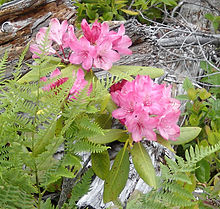- Rhododendron macrophyllum
-
Rhododendron macrophyllum 
Rhododendron macrophyllum in the Biscuit Fire area of Rogue River-Siskiyou National Forest, Oregon, USA Scientific classification Kingdom: Plantae (unranked): Angiosperms (unranked): Eudicots (unranked): Asterids Order: Ericales Family: Ericaceae Genus: Rhododendron Subgenus: Hymenanthes Section: Ponticum Species: R. macrophyllum Binomial name Rhododendron macrophyllum
D.Don ex G. Don 1834 (R. californicum Hook.f.)Rhododendron macrophyllum, the Pacific Rhododendron, Coast Rhododendron or Big Leaf Rhododendron, is a broadleaf evergreen rhododendron species native to western North America.
Contents
Distribution
Pacific rhododendron is found along the Pacific Coast from British Columbia to Monterey County in California [30,41]. It is widely distributed in the Coast and Cascade Mountain Ranges [9,30,43]. Pacific rhododendron is less abundant in the Coastal Mountains of Washington and northern Oregon and more common south of the Siuslaw River [27].
The northern limit of the range of the Pacific Rhododendron is somewhat north of the border between Canada and the US in British Columbia. It is found as far south as Monterey Bay in California[1]. It is mostly coastal in distribution but extends its range eastward to locations in the Cascade Mountains in Oregon, Washington and British Columbia[1].
Description
It is a shrub growing 2–9 m tall. The leaves, retained for 2–3 years, are 7–23 cm long and 3–7 cm broad. The flowers are 2.8–4 cm long, with five lobes on the corolla; color is usually pink, although variants exist.
Habitat
This species, like many rhododendrons, thrives in disturbed habitats such as roadside embankments and recently deforested wildlands. The photo at the top of this page was taken in a forest in Oregon that was burnt over just three years before the time of the photo (2005). The rhododendrons in that area, both Pacific Rhododendrons and Western Azaleas, are already regrowing and blooming from the unburnt roots.
History and cultivation
Archibald Menzies found this shrub growing along with Arbutus menziesii in May of 1792 when he and George Vancouver made their second landfall after leaving Hawaii, near present day Port Discovery[2]. Seed was sent to England in 1850 by William Lobb.
Pacific Rhododendron shrubs can be scraggly and the flowers are often much less impressive than those of its relatives. Also, it is easy to kill this plant with an excess of summer watering - while not watering it can leave it looking pathetic[citation needed]. In its native range and once established it can be a trouble free attractive plant requiring a minimum of attention.
In recent years it has been the main focus of a study group at the Rhododendron Species Foundation in Federal Way, Washington, the Western North American Rhododendron Species Project (WNARSP). The WNARSP is documenting the detailed range and forms of all of the western North American rhododendron species.
Symbolism
The Pacific Rhododendron is the state flower of the state of Washington in the USA.
References
- ^ a b http://www.fs.fed.us/database/feis/plants/shrub/rhomac/all.html#DISTRIBUTION AND OCCURRENCE
- ^ Justice, Clive L. Mr. Menzies' Garden Legacy, Plant Collecting on the Northwest Coast. 2000. Cavendish Books. ISBN 978-1-55289-020-2
Other sources
- Davidian, H. H. The Rhododendron Species, Volume III - Elepidotes continued. 1992. Timber Press. ISBN 978-0-88192-168-7.
- Cox, Peter A. & Kenneth N.E. The Encyclopedia of Rhododendron Species. 1997. Glendoick Publishing. ISBN 978-0-9530533-0-8.
Categories:- Rhododendron
- Flora of California
- Flora of Oregon
- Flora of Washington (state)
- Garden plants of North America
- Symbols of Washington (state)
- United States state plants
Wikimedia Foundation. 2010.
